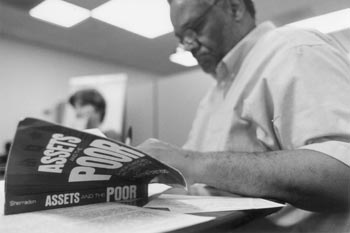![[MetroActive News&Issues]](/gifs/news468.gif)
[ Sonoma County Independent | MetroActive Central | Archives ]
IDA Ideal
Eye on the prize: David Johnson of the Community Baptist Church is helping to lay the groundwork for the low-income 401k plan.
Is Sonoma County ready for 401k plans for the poor?
By Janet Wells
MARTHA MICELI once had a piece of the American Dream: a house, a truck, a business. Then 15 years ago her husband had a heart attack, and they lost everything. "There was no happy ending in sight. My state of mind was chaotic, full of anxiety," the mother of two recalls.
Then Miceli heard about Individual Development Accounts, an innovative savings program for the poor that raises money from community groups or government grants to match every dollar she put into the bank.
Miceli and her husband started saving $40 a month toward owning a home. "Now we're looking forward to something," the upstate New York resident writes in a newsletter on the IDA program. "We finally have goals. This is the first time we've had savings in 20 years."
Sonoma County community leaders are pursuing a similar program for local residents who, like Miceli, can't even begin to dream when they are scrambling to cover rent and food. "This is a very exciting concept," says Tula Jaffe, advocate for the homeless and a member of Family Action of Sonoma County. "In spite of the wonderful economic boom we're feeling in the nation and in Sonoma County, there are many families here that are living on very, very small wages."
Even the one in five Sonoma County families that has trouble making ends meet can save money--if they have incentive, Jaffe says. "This is a way for low-income people to build assets so they can be economically self-sufficient."
IDA accounts are designed to help low-income families accumulate a few thousand dollars to put toward owning a home, opening a small business, or getting higher education. Participants save monthly over a one- to four-year period, and banks, foundations, churches, and grants provide matching funds, usually from one to four dollars for every dollar saved.
"We're trying to make a point about who the poor are and what they are capable of," says Robert Friedman, one of the leaders in organizing IDA programs around the country. "Just because you're poor doesn't mean you can't participate in the American Dream. There are people who are poor who have tremendous drive, talent, energy, and vision. IDA accounts leverage that."
Friedman, founder and chairman of the board of the Washington D.C.-based Corporation for Enterprise Development, says that IDAs are the most innovative financial development for the poor since the Homestead Act or the GI Bill.
"The structure of welfare, Social Security, and disability [benefits] give shelter and food and clothing. But it seems to me that the limits of that approach are equally obvious now," he says. "They mitigate the pain of poverty, but it doesn't offer a way out, and often is a disincentive to moving forward."
THERE ARE almost 100 IDA programs in the country serving hundreds of individuals, with another 100 in the pipeline, Friedman says. The North Bay IDA Collaborative stems largely from efforts by a group that was initially mainly from the Peace and Justice Center of Sonoma County. David Johnson of the Community Baptist Church and a former board member of the center challenged the group to do something about economic development for the county's poor. Johnson, along with a small group including Jaffe, Petaluma Valley Hospital physician Earl Herr, and Exchange Bank administrator Buffy Dyess, is spearheading efforts to find partner groups willing to help fund and manage an IDA program in Sonoma County.
IDAs are not just a feel-good program for the community groups and foundations that participate, Friedman told a group of about 25 representatives from various local agencies, businesses, and social service groups who attended an information meeting in Santa Rosa in February. The short-term benefits include good publicity and tax credits, he says. And if the program expands the way Friedman hopes, the potential long-term market is huge.
"You're talking $33 billion a year leveraging the savings, and millions of accounts," he says.
A year-old IDA program in the East Bay has almost 100 individuals saving $10 to $80 a month, with most of the participants planning to use their money to buy a home. The program has almost reached its target of $400,000 in matching funds, to be distributed over four years, at a rate of $2 paid for every $1 saved. All of the East Bay's matching funds have come from community groups and foundations, rather than government grants.
"People have called us to say they can't pay the rent, but they want to contribute to their IDA," says Candace Acevedo of Consumer Credit Counseling, which provides financial training to East Bay program participants. "The program changes people's spending habits so they really look where every penny goes. We've found that it's not that hard to cover rent and come up with an extra $25 to $50 for the IDA program.
"Everybody sees what the promises are," Acevedo adds. "This is the first time these people have invested in themselves."
[ Sonoma County | MetroActive Central | Archives ]
Copyright © Metro Publishing Inc. Maintained by Boulevards New Media.
![]()

Michael Amsler
To help support and help further the development of the IDA program, call the North Bay IDA Collaborative (100 E St., Suite 212, Santa Rosa) at 578-5904.
From the March 4-10, 1999 issue of the Sonoma County Independent.